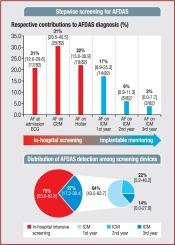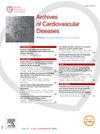卒中后心房颤动分步筛查策略的疗效和临床意义:来自 SAFAS 研究的启示。
IF 2.2
3区 医学
Q2 CARDIAC & CARDIOVASCULAR SYSTEMS
引用次数: 0
摘要
背景:目的:我们评估了中风后房颤检测(AFDAS)的顺序组合筛查技术的适用性。我们还根据房颤检测时间比较了患者的特征:方法:前瞻性地招募了因急性缺血性中风入院的既往无房颤的患者。经过基于心电图、遥测监测和院内长期 Holter 的 AFDAS 逐步筛选方法后,隐源性中风患者接受了植入式心脏监测仪(ICM)。早期房颤定义为住院期间诊断出的房颤,晚期房颤定义为 ICM 诊断出的房颤:结果:在纳入的 240 名患者中,104 人(43.3%)记录的中风原因与房颤无关。在剩余的 136 名患者中,有 82 人(60.3%)在急性筛查阶段或通过 ICM 的 3 年随访期间发现了房颤。分别有 17 名(20.7%)、25 名(30.5%)和 18 名(22.0%)患者通过心电图、遥测和院内长期 Holter 监测诊断出早期房颤。在 76 名因隐源性卒中而植入 ICM 的患者中,有 22 名患者(28.9%)被检测出房颤。除年龄和中风部位外,早期房颤检测的患者与晚期房颤检测的患者并无差异,尤其是在心房心肌病标志物的患病率方面:结论:采用分步法筛查房颤,可以在相当多的患者住院期间及早发现房颤。在检测远期发作的房颤方面,ICM 仍是非侵入性筛查工具的补充。本文章由计算机程序翻译,如有差异,请以英文原文为准。

Efficacy and clinical implications of a stepwise screening strategy for atrial fibrillation after stroke: Insights from the SAFAS study
Background
Although guidelines recommend screening patients for atrial fibrillation (AF) after stroke, the optimal timing and combination of screening tools remain unclear.
Aims
We evaluated the suitability of a sequential combination of screening techniques for AF detected after stroke (AFDAS). We also compared patient characteristics according to the timing of AFDAS.
Methods
Patients without previous AF admitted for acute ischaemic stroke were prospectively enrolled. After a stepwise screening approach for AFDAS based on electrocardiogram, telemetry monitoring and in-hospital long-term Holter, patients with cryptogenic stroke underwent implantation of an implantable cardiac monitor (ICM). Early AFDAS was defined as AF diagnosed during hospitalization and late AFDAS as AF diagnosed on an ICM.
Results
Of the 240 patients included, 104 (43.3%) had a documented cause of stroke not related to AF. Among the 136 remaining patients, AFDAS was detected in 82 (60.3%) during the acute screening phase or during the 3-year follow-up by ICM. Early AFDAS was diagnosed by ECG, telemetry and in-hospital long-term Holter monitoring in 17 (20.7%), 25 (30.5%) and 18 (22.0%) patients, respectively. Among 76 patients who had an ICM implanted for cryptogenic stroke, AF was detected in 22 patients (28.9%). Except for age and stroke location, patients with early AFDAS did not differ from those with late AFDAS, particularly with regard to the prevalence of atrial cardiomyopathy markers.
Conclusion
A stepwise approach to AFDAS screening allows early detection of AF in a considerable number of patients during their hospitalization. ICMs remain complementary to non-invasive screening tools for the detection of remote episodes of AF.
求助全文
通过发布文献求助,成功后即可免费获取论文全文。
去求助
来源期刊

Archives of Cardiovascular Diseases
医学-心血管系统
CiteScore
4.40
自引率
6.70%
发文量
87
审稿时长
34 days
期刊介绍:
The Journal publishes original peer-reviewed clinical and research articles, epidemiological studies, new methodological clinical approaches, review articles and editorials. Topics covered include coronary artery and valve diseases, interventional and pediatric cardiology, cardiovascular surgery, cardiomyopathy and heart failure, arrhythmias and stimulation, cardiovascular imaging, vascular medicine and hypertension, epidemiology and risk factors, and large multicenter studies. Archives of Cardiovascular Diseases also publishes abstracts of papers presented at the annual sessions of the Journées Européennes de la Société Française de Cardiologie and the guidelines edited by the French Society of Cardiology.
 求助内容:
求助内容: 应助结果提醒方式:
应助结果提醒方式:


